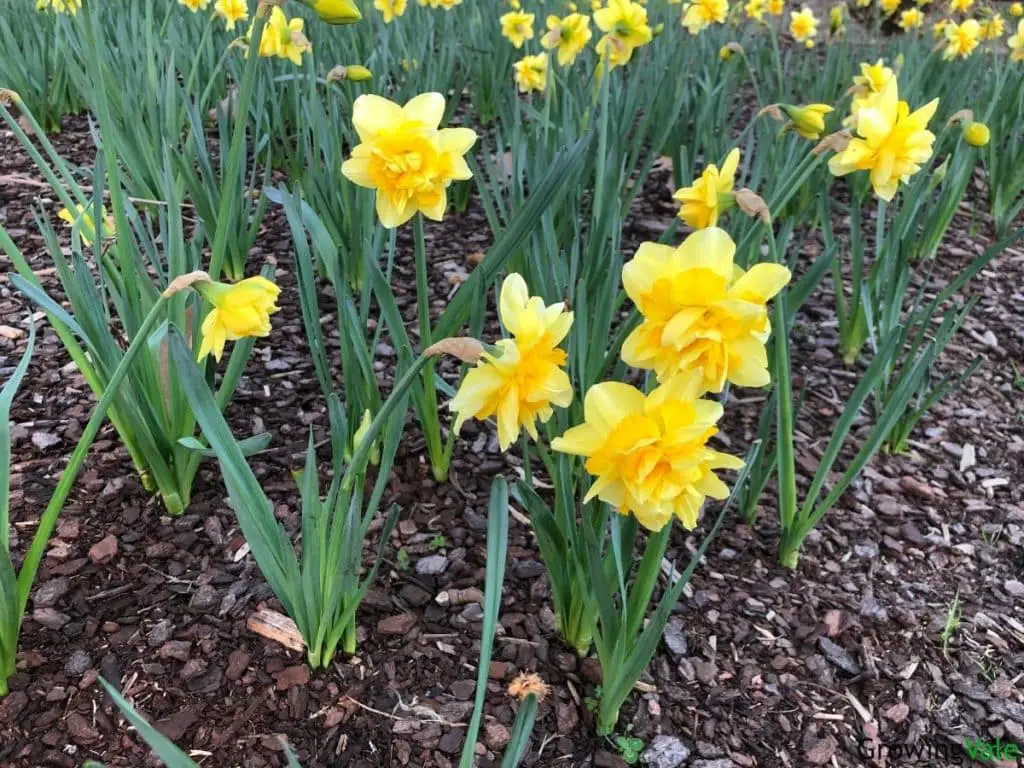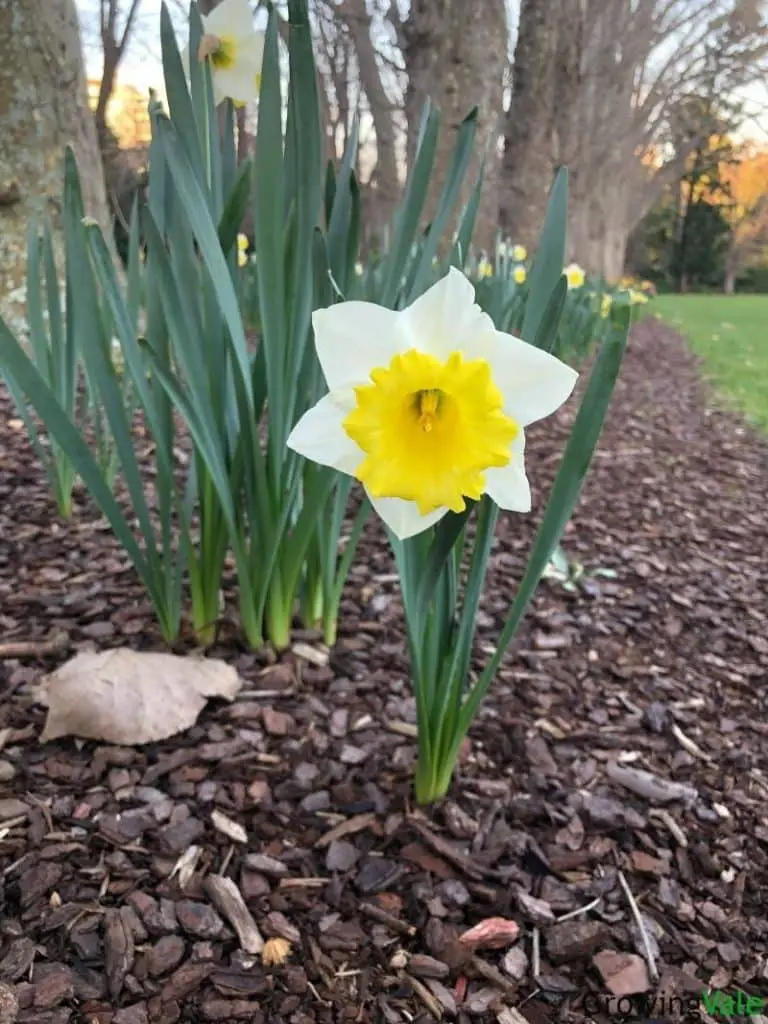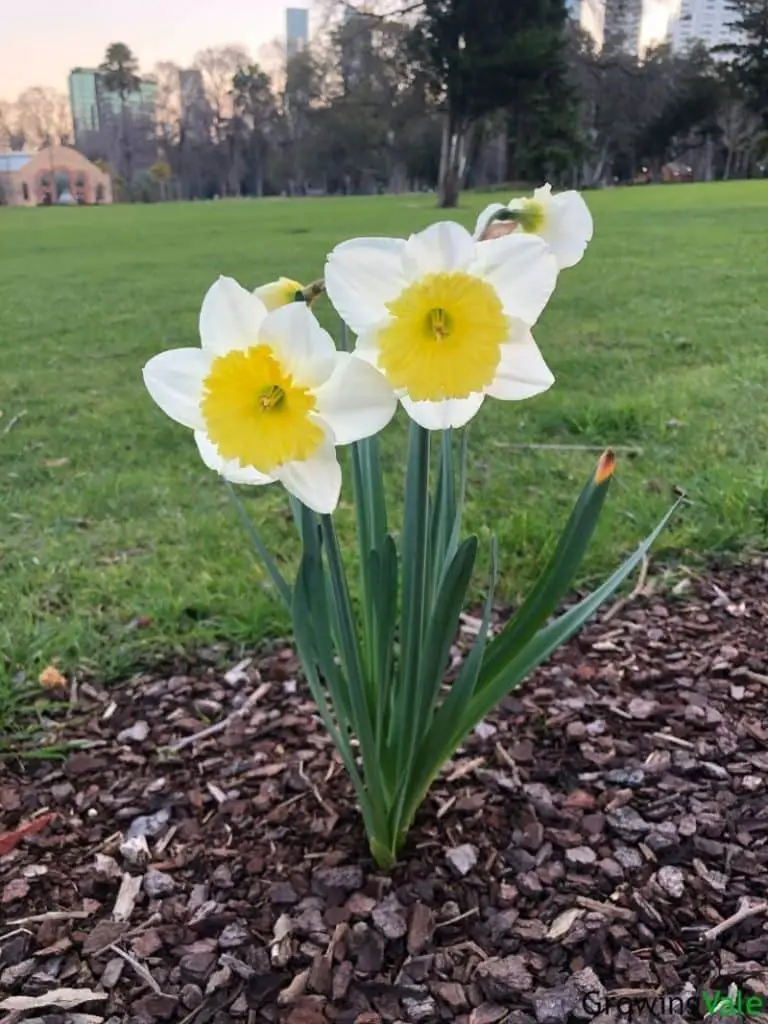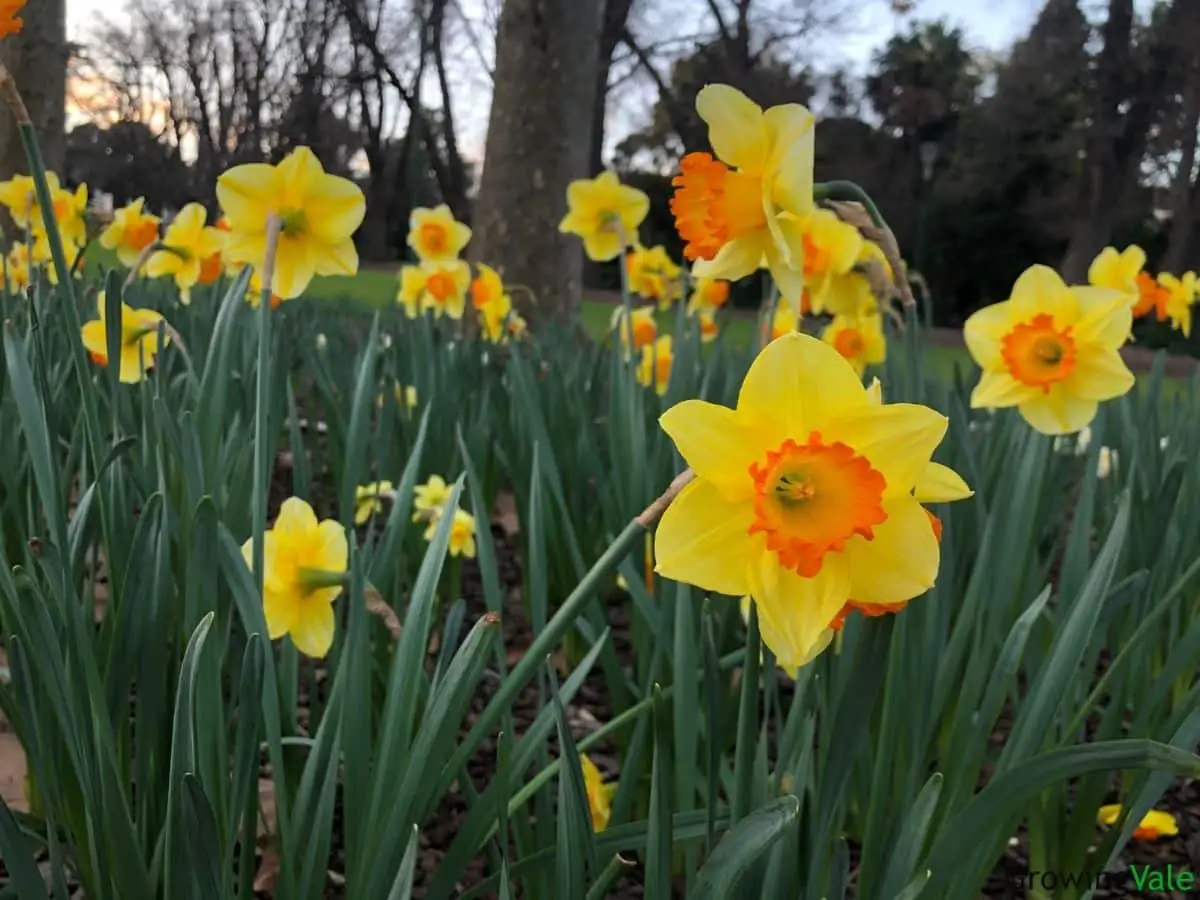Narcissus is a genus of around 50 species. They are bulbous plants in the amaryllis family, Amaryllidaceae. Most species are spring flowering perennials! They are extremely popular as spring bulbs, and their flowers are easily recognized in the wild by their large cupped yellow flowers.
They easily hybridize in the wild, but many horticultural crosses have created beautiful daffodil varieties, many of which have fragrant flowers!
Some garden favorites are the N. pseaudonarcissus (most commonly recognized as a daffodil), N. jonquilla (jonquil), and N. poeticus (also sometimes called poet’s narcissus).
History
Narcissus are primarily native to northern Europe and have become synonymous with the coming of spring! Most daffodils have a flowering season between February and March and are extremely versatile plants.
Daffodil bulbs grow well in containers, along borders, and on lawn displays. They suit most garden styles and are great for adding some spring color back to the garden after winter.
The genus Narcissus is named after the character Narcissus from Greek mythology. According to the myth, he was a beautiful young boy who became so obsessed with his reflection, that the god turned him into a flower!
Daffodil flowers are extremely easy to recognize by their central trumpets and 6 outer tepals. Their flowers are usually white or yellow and sit atop a sturdy, upright flower stem. Their flowers can be doubled and come in various shapes and sizes!
They look best planted in groups of at least 6 for an attractive sweep of color! If planted under the right conditions, daffodil bulbs can be left in the ground for years and years, making them perfect for the low-maintenance gardener.
Plant Facts
| Scientific name | Narcissus spp. |
| Common names | Daffodil, Jonquils, Narcissus, Paperwhites, Tazettas |
| Genus | Narcissus |
| Family | Amaryllidaceae |
| Height | 0 ft. 8 in. – 2 ft. 6 in. |
| Width | 0 ft. 6 in. – 1 ft. 0 in. |
| USDA Plant Hardiness Zone | 4 – 8 |
| Origin | Europe |
| Flower colors | White, Yellow, Orange, Pink, Variegated |
| Blooming season | Winter, Spring |
| Plant/Flower special features | Fragrant, showy flowers |

How to Plant and Grow Daffodil Flower
Daffodil bulbs are divided into 13 groups botanically. These are based on their flower form and other characteristics. It’s good to do some research before purchasing any daffodil plants to make sure they are the right fit.
Daffodil bulbs can easily be purchased online or in-person from nurseries or garden centers. When buying them in person, look at bulb size and always choose the largest bulbs, squeezing them to make sure they are firm. Avoid purchasing bulbs that are showing indications of mold.
Plant loose daffodil bulbs in fall, preferably September, and potted bulbs in spring before they begin to flower.
Growing Daffodil Flowers in Beds
To plant daffodils in beds, prepare the site by loosening up the soil and removing any weeds. Mix in organic matter to improve soil drainage and structure. If adding a general bulb fertilizer, now is the time to mix it into the soil following the package instructions.
Make sure the site doesn’t have well drained soil and gets the right amount of light (full sun to partial shade)
Dig a hole that is three times as deep as the daffodil bulb. Place the bulb into the hole, “nose” or shoot faced up, double-checking it is three times as deep as its height. This ensures it will flower well for the next few years.
Gently replace the soil on top of the bulb and carefully pat the soil down. Using too much force can damage the bulbs, so be gentle!
Planting daffodils with regular-sized bulbs 4 to 8 inches apart and small bulbs 3 to 5 inches apart.
For fall-planted daffodil bulbs, or if the ground is already moist, watering post-planting isn’t too important. Otherwise, water the bulbs immediately after planting.
Growing Daffodil Flowers in Containers
Daffodils grow well in containers given they are in full sun to partial shade in well draining soil! Select Narcissus varieties with small bulbs for small containers or window boxes, and larger, taller types of daffodils for bigger containers.
Follow the above instructions for planting, again, planting daffodil bulbs three times as deep as their height. They should also be planted at least one bulb apart.
For temporary container displays, it’s possible to plant the bulbs shallower and to pack them more closely together. But, they will need to be transplanted into the garden in late spring after the blooming season is over. Daffodil bulbs look incredible planted alongside tulips and other spring bulbs.

How to Propagate Daffodils
Over time, daffodils will naturally produce new bulbs. This will expand the clump gradually, but they can also be propagated from seeds, by division, or by chipping the bulbs.
Propagating Daffodils from Seeds
This is one of the easier methods to propagate daffodils, but cultivars may not grow true to the parent plant. Daffodil plants grown from seeds can also take 5 to 6 years to flower.
Wait until the spent flowers have dried out. Collect the seeds and separate them from the chaff. Sow them thinly on the top of seed compost, then cover the seeds with a thin layer of fine grit or sifted compost. Place the trays in a cold frame or unheated greenhouse for winter protection. Make sure the compost stays moist.
Alternatively, the seeds can be sown in a sheltered spot in the garden. Expect the seeds to germinate the following spring.
Propagating Daffodils by Division
Daffodils naturally produce baby bulbs (or offsets) from the parent bulb. These can be removed and replanted when lifting the bulbs after the foliage has died down (done by gardeners that would like to plant something else over summer). Otherwise, this can be done when the daffodil plant has become too congested after 3 to 5 years.
Many gardeners also prefer to dig up their daffodil bulbs in the fall and replant them in a different spot. This would also be a good time to remove any offsets and replant them.
To propagate daffodil flowers by division, carefully dig around the daffodil, giving a wide berth to make sure the shovel doesn’t damage the bulbs. Once plants are lifted, gently remove any soil to better see the daffodil bulbs and any offsets.
Some daffodil bulbs may have offsets, and others may not. Those with offsets can be replanted immediately in the same or different spot. Discard any bulbs that are soft or damaged.
For daffodil bulbs with offsets, gently rock and twist the baby bulbs until they separate from the parent bulb. Smaller offsets do better when replanted into a container until they grow larger, whereas larger offsets can be replanted directly in the ground.
Take care to prepare the garden bed or container beforehand, to reduce the risk of the daffodil bulbs drying out before they are replanted.
Propagating Daffodils by Chipping the Bulbs
Chipping the bulb is a method that works well for daffodil plants, however, it is the most complicated way to propagate daffodils.
First lift a mature, dormant daffodil bulb without leaves, and clean off any soil. Remove the outer, papery skin and trim back the roots. Using a sharp knife, remove the “nose” of the bulb. Cut the bulb into 8-16 sections (or chips) of a similar size, making sure each section includes a part of the basal plate.
Leave the chips on a rack for 12 hours to dry out, before putting them in a clear plastic bag with vermiculite and water at a ratio of 10:1. Blow the bag up with air before sealing it and placing it in a dark place at 68ºF. Leave the bag for 12 weeks, occasionally checking for and removing any rotting chips.
After 12 weeks have passed, pot up the chips individually in small, 3-inch pots with a well-draining compost. They should have formed small bulblets. The chips need to be planted with the basal plate facing downwards, with the bulbets covered by ½ an inch of soil. Any scales (leaves of the bulb) can be left exposed as these will rot away as the bulbet grows.

Daffodil Care and Maintenance
Here are some care tips for your daffodil plants:
Soil
Daffodils prefer well-drained, organically-rich, medium moisture soils. Good drainage is essential to prevent the bulbs from rotting.
Water
During the growing and blooming season, daffodils need around 1 inch of water a week (from rain or manual watering).
Usually, daffodil bulbs don’t require any additional watering, as the rain is enough, but they should be watered during long dry spells, or if they are in a sheltered spot, like under a large tree.
Container-grown daffodil bulbs will need to be watered regularly, as the soil can dry out easily. Do this throughout the growing season, until the foliage dies down and the plants become dormant.
After the growing season daffodil bulbs enter dormancy and do not need any additional watering. During this time, they are drought-tolerant.
Fertilizer
New daffodil bulbs don’t need feeding as they should flower well during their first year. However, older bulbs, especially those in poor soils, will benefit from spring feeding as they are beginning to emerge.
Use a general bulb fertilizer at a concentration of 20oz per yard, and spread it evenly on top of the soil around the bulbs.
Container-grown daffodil plants should be fertilized every 7-10 days to maximize flowering. Use a high-potassium liquid feed from when the first shoots begin to appear until the foliage begins to die down.
Daffodils benefit from a thick layer of organic matter or mulch spread over the soil either in spring or fall. This prevents the soil from drying out and deters weeds.
Sunlight
Plant daffodil bulbs in full sun to part shade. Daffodils bloom in late winter or early spring which is a perfect addition to your garden.
Temperature and Humidity
Daffodils don’t do well in warmer climates. They grow and flower in response to weather conditions with alternating warm and cool periods, and require a warm (60 – 70ºF) – cool (32 – 40ºF) – warm (50 – 60ºF) cycle.
Do not plant daffodil bulbs during periods where temperatures are below 23ºF as this will injure the plant.
Pest and diseases
Daffodils are incredibly easy to grow, and with the right soil and care, they are known for being pest-free plants! In poorly-drained soils, they can suffer from root rot.
Infrequent pests and diseases that may affect daffodil plants and flower buds are the narcissus bulb fly, slugs, snails, narcissus nematode, bulb scale mite, and narcissus yellow stripe virus.
Pruning
Many gardeners deadhead their daffodils once their flowers fade. This has two benefits. It keeps the flower bed looking neat, and it prevents seed pods from forming. This encourages the plants to put their energy back into their bulbs for a good early spring flowering next year!
It’s best to wait at least 6 weeks (or right before the leaves die) before cutting back any leaves. Cutting them back too early prevents photosynthesis and can reduce flowering the following spring.
Overwintering Daffodils
The majority of daffodil plants are hardy and do not need winter protection. However, those grown in containers will need to be protected from overly-wet soil conditions as this can cause root rot.
Toxicity
Daffodils contain phenanthridine alkaloids that make them toxic to humans. Any part of the plant including the bulb eaten in large quantities will cause nausea, vomiting, diarrhea, and convulsions. Handling the plant can cause contact dermatitis (also known as “lily rash”).
In extreme cases, consuming daffodils can cause low blood pressure, and cardiac arrhythmias, and be potentially fatal. Always take care while handling, wear gloves if possible, and do not ingest any part of the plant, including the bulb, which is the most poisonous part.
Uses of Daffodils
Daffodils are extremely popular in all types of gardens. They look especially striking when planted en masse in large drifts. It isn’t uncommon to see their fragrant flowers in public gardens and parks!
Daffodil blooms are also beautiful as cut flowers, especially those with fragrant flowers. Pair them with tulips and other spring flowering bulbs for a vibrant display.
In the past, daffodil bulbs (which are poisonous) were used in medicines and as a purgative. The oil from jonquil daffodils is used in fragrance and as an essential oil.
Common Varieties and Cultivars
It’s lovely to have many different types of daffodils in your garden. Here are some of the most popular and beautiful Narcissus species, cultivars, and varieties:
- (Narcissus cyclamineus) Cyclamen-flowered Daffodil – This daffodil variety grows as tall as 8 inches. It has drooping, bright yellow blooms. Its trumpets are slender while its outer petals curve back dramatically.
- (Narcissus cyclamineus) “Peeping Tom” – Peeping Tom has pretty golden yellow flowers. Its trumpet is long and flared at the mouth, and is surrounded by slightly reflexed outer tepals. It can be up to 15 inches tall.
- (Narcissus jonquilla) Jonquil – These sweet miniature daffodils grow as tall as 12 inches. It produced fragrant clusters of dainty, small cupped trumpets surrounded by outer petals. These daffodils make lovely cut flowers.
- (Narcissus pseudonarcissus) Wild Daffodil – This small trumpet daffodil will grow as tall as 14 inches. Its flowers are large cupped at 1.5 to just over 2 inches wide. They have deep yellow trumpets and paler outset segments. These types of daffodils are wonderful planted with tulips or as cut flowers.
Conclusion
Daffodils belong to the genus Narcissus. There are around 50 species in the garden, many of which are extremely popular with gardeners. Botanically, garden daffodils are divided into 13 groups, but some common favorites are N. pseudonarcissus (most commonly recognized as a daffodil), N. jonquilla (jonquil), and N. poeticus (also sometimes called poet’s narcissus).
Their genus name comes from the Greek Myth of a young boy named Narcissus who became so entranced by his own reflection that the gods turned him into a flower! Daffodil plants are perennial bulbs that require weather conditions with warm-cool-warm period to grow and flower. They produce fragrant clusters in early spring that are good as cut flowers. Daffodil plants are easily propagated by several methods and can be left in the garden for years without needing any extra attention.
Grow daffodils in beds and containers in full sun to part shade in open woodland, cottage-style, and courtyard gardens. Typically, most daffodils are late winter or spring flowering, adding some much-needed spring color after the cold months! Their fragrant flowers are most commonly white and yellow, but pink, orange, and bi-colored daffodil varieties exist. They are one of the best flowers for your garden.
See more: Daffodil flower meaning and symbolism

